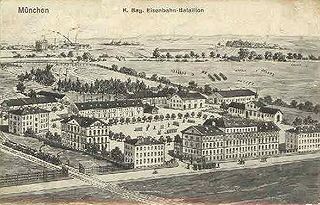You can help expand this article with text translated from the corresponding article in German. (November 2011)Click [show] for important translation instructions.
|

Technisches Rathaus is a building located in Munich, Bavaria, Germany. [1]
You can help expand this article with text translated from the corresponding article in German. (November 2011)Click [show] for important translation instructions.
|

Technisches Rathaus is a building located in Munich, Bavaria, Germany. [1]

The Rathaus-Glockenspiel is a large mechanical clock located in Marienplatz Square, in the heart of Munich, Germany. Famous for its life-size characters, the clock twice daily re-enacts scenes from Munich's history. First is the story of the marriage of Duke Wilhelm V to Renata of Lorraine in 1568, followed by the story of the Schäfflerstanz, also known as the coopers' dance.
Rathaus is the German word for a seat of local, legislative and/or executive government.

Marienplatz is a central square in the city centre of Munich, Germany. It has been the city's main square since 1158.

Holnstein Palace is an historic building in Munich, Southern Germany, which has been the residence of the Archbishop of Munich and Freising since 1818.

Munich East station is a railway station in Munich, the state capital of Bavaria, Germany. It opened as Haidhausen station in 1871 on the new Munich–Mühldorf and Munich–Rosenheim railway lines. The station is operated by DB Station&Service, a subsidiary of Deutsche Bahn AG. It is classified as a Category 1 station, one of 21 in Germany and two in Munich, the other being München Hauptbahnhof. It is the city's third interregional station besides München Hauptbahnhof in the city centre and München-Pasing in the west.

The New Town Hall is a town hall forms the northern part of Marienplatz in Munich, Bavaria, Germany. It hosts the city government including the city council, offices of the mayors and a small portion of the administration. In 1874 the municipality had left the Old Town Hall for its new domicile.
Nikolaus Riehl was a German nuclear physicist. He was head of the scientific headquarters of Auergesellschaft. When the Russians entered Berlin near the end of World War II, he was invited to the Soviet Union, where he stayed for 10 years. For his work on the Soviet atomic bomb project, he was awarded a Stalin Prize, Lenin Prize, and Order of the Red Banner of Labor. When he was repatriated to Germany in 1955, he chose to go to West Germany, where he joined Heinz Maier-Leibnitz on his nuclear reactor staff at Technische Hochschule München (THM); Riehl made contributions to the nuclear facility Forschungsreaktor München (FRM). In 1961 he became an ordinarius professor of technical physics at THM and concentrated his research activities on solid state physics, especially the physics of ice and the optical spectroscopy of solids.

The TUM Institute for Advanced Study (TUM-IAS) is a scientific institution of the Technische Universität München, conducting research in science, engineering and humanities. Its building is located on its Garching campus.
Baş Əmirxanlı is a village in the Davachi Rayon of Azerbaijan. The village contains a dwelling dating from the Middle Ages which is registered with the Ministry of Culture and Tourism.

The Old Town Hall, until 1874 the domicile of the municipality, serves today as a building for representative purposes for the city council in Munich, Bavaria, Germany. The Old Town Hall bounds the central square Marienplatz on its east side.

The Eisenbahnkaserne was a military barracks in Munich that existed from 1890 to 1976. The "Kasernement des Eisenbahnbataillons" was built in 1888 and 1889. It was located west of today's Olympiapark on Dachauer Straße, where the Bundeswehr Administration Centre is now located.

The Bavarian War College, also Bavarian Staff College was the highest military facility to educate, instruct, train, and develop general staff officers.

Kehl station is a railway station in Kehl, a town in southwestern Germany in the Ortenaukreis, Baden-Württemberg. It is situated on the Appenweier–Strasbourg railway, with trains crossing the Rhine into France to reach the latter destination. Both sides being within the Schengen Area, no passport or border controls apply.

Schleißheimer Straße is the second longest street in Munich after Dachauer Straße with a length of 8.14 km. It starts in the city centre at Stiglmaierplatz, leads through five districts and ends at Goldschmiedplatz. It takes its name from the northern suburb of Oberschleißheim, where it originally ended.

Berg am Laim is a southeastern borough of Munich, Bavaria, Germany.

The Riedlhütte narrow-gauge railway is a not for profit light railway in Sankt Oswald-Riedlhütte in the Bayerischer Wald.

Pasing Town Hall is the former town hall of the municipality of Pasing, Bavaria, Germany, which was incorporated into Munich in 1938.

The Old Technical Town Hall, is a communal service building of the city administration and headquarters of the section for the planning and building regulations of Munich, Bavaria, Germany. It is the oldest high-rise building in Munich and is still referred to as "Das Hochhaus" by old-established Munichers, although there are now more and higher high-rise buildings.
Erwin Schleich was a German architect, architectural conservator, and architectural historian known for his post-war reconstruction of buildings and monuments in Munich.

Theodor Pabst was a German architect, civil servant and professor.